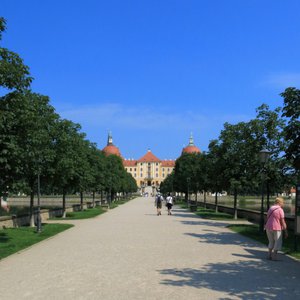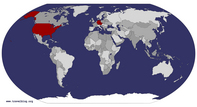Advertisement
Published: July 21st 2014

 Schloß Moritzburg
Schloß Moritzburg
That's Gudrun there on the right in the pink shirt; she's looking for carp in the lake.After another late night, it was another not-so-early-but-early-enough morning for us. We had two things on the docket for today: the king's hunting lodge, Schloß Moritzburg, and Meißen, a nearby city containing a porcelain factory and another castle and impressive cathedral. After the usual groggy, quiet breakfast, we piled in the car again, and headed out for Moritzburg.
First, though, Dieter took us on a slow drive through
Hellerau, known as the "Garden City". It seems to be made up almost completely of very small houses and apartments, each with a small garden with flowers or vegetables or both; this makes for a beautiful environment which appears to be very quiet and slow-paced. It is also the home of the
Festspielhaus Hellerau, which Dieter drove by for us. It has a pretty storied history, including occupation by the Nazis and abuse by the Soviets (who tore the yin-yang off and replaced it with a red star), and general decline during the DDR times.
After Hellerau, we headed to Moritzburg in earnest.
Schloß Moritzburg is north of Dresden, and situated on an artificial island surrounded by an artificial lake, which, according to Dieter, is drained every year in the fall, and all

 Schloß Moritzburg
Schloß Moritzburg
It is a very pretty palace and/or castle.of the carp collected up and put somewhere, and then filled again in the spring, with the carp replaced. That seems like a lot of work to me, but I guess maybe they don't want to carp to die in the winter, and the lake isn't deep enough for them to just go live below the thermocline in the winter.
Now, you'll notice that it's called
Schloß Moritzburg;
Schloß means "palace", and
Burg means "castle", so it is both a palace and a castle (although, as castles go, this one does not appear to have been built for defense, so I think it was more of a play castle). Moritzburg served as a hunting lodge for August the Strong; originally it was the site of an earlier hunting lodge for Duke Moritz of Saxony in the 16th century, which gave it its name. I didn't take any pictures of the inside, though I don't now recall whether that was because photography was
verboten, or whether the light was bad. The inside was interesting enough, though, with all manner of hunting artifacts, and antlers of various deer and elk, and all kinds of stuff made out of feathers.
Though

 The Two Moritzburgs
The Two Moritzburgs
The conditions were almost perfect for this photograph. More blue sky and fewer clouds would have been better.my mother's side of the family hunted, I've never hunted anything. When I was little, though, we enjoyed the benefit of various deer hunts by my grandfather, uncle and father, and I've no issue with hunting for food (nor even for population control, but I'll leave that to others). I'm not big on sport hunting though, and though the audio guide gleefully recounted the hunts, I was a little bit sickened by the whole thing. I mean, really, it went like this: dogs run the deer until it's really tired, then some dudes run out and hamstring the deer so it can't run any more, and then finally, some noble dude "delivers the killing cut". Seriously? That's not hunting, that's just orchestrated slaughter, and I don't see anything at all sporting in it.
So, though I really liked the architecture of the palace and all, I wasn't left feeling all that good about its purpose.
I did get a nice shot of the palace and its reflection in the lake, though.
After Moritzburg, we had little ice cream cones, and sat in the shade a bit, and then headed on to
Meißen.
The European royalty really

 Meißen Factory: Porcelain Lilacs
Meißen Factory: Porcelain Lilacs
Even in person, they looked like real lilacs to me.dug Chinese porcelain, but nobody in Europe knew how to make it. August the Strong had heard that a dude named Johann Friedrich Böttger had figured out the old alchemy problem of turning stuff into gold, so he immediately put Böttger into "protective custody" (a tactic which lived in via National Socialism and the DDR, by the way, but for different reasons, and still not at all protective) and set him to the task of making some gold. This proved to be a problem, because Böttger had discovered no such thing. However, eventually, with the help of Ehrenfried Walther von Tschirnhaus, the problem of shiny white porcelain was solved, and August set Böttger up inside the castle to manufacture porcelain (in the castle to protect the secret of its manufacture). Thus, Meißen became the first manufacturer of porcelain in Europe, and
Meißen porcelain is still produced and sold.
We took a brief tour showing some of the stages of manufacture, and it was pretty neat to watch the folks work at their craft (although, I wondered for a bit how you end up with demonstration duty; do you have to be really good, and it's a shift that is coveted?).

 At the End of the Day
At the End of the Day
I imagine this is what they do with all the demonstration blanks they make throughout the day.There was also a porcelain museum with a lot of exhibits which we walked through, at the end of which, there was a kind of a "modern porcelain art" room. When we entered the room, I took note of some flowers on the other side of the room. Even up close, it took me a moment to realize they were not real flowers, but actually porcelain. The lilacs were just phenomenal. Any one of them could be yours for the low low price of 70,000 Euros. There was also an exhibit in the middle of the room where it looks like they piled up all the blanks from cup demonstration and then fired them all at once, which was also pretty neat.
We finished up at the factory/museum, and took the car over to a parking garage at the base of the cliff atop which sits the castle. There is a peculiar elevator/funicular here that costs a Euro for a round trip ride up to the castle and back, and we rode that up, which dropped us off right inside
Albrechtsburg, the castle in Meißen. Inside the castle is a bunch of stuff, including the Meißen cathedral, a music

 Imposing Cathedral
Imposing Cathedral
The cathedral is very large and impressive, inside and out.school of some sort, and a
Biergarten. It was time for some refreshment, so we stopped at the beer garden for a bit. Cheryl and I had
Radlers, and I had a tasty
Sächsische Kartoffeln Suppe (Saxon tater soup) and Cheryl had
Eis, of which I was a tiny bit jealous. We sat and enjoyed the shade and the view for a bit, and then headed to the cathedral.
The wikipedia page apparently doesn't deem it necessary information, but the cathedral is actually
Dom St. Johannis und St. Donatus (yes, that's two patrons). It is gorgeous inside, and they allowed photography, so I took a bunch of photographs, some of which even came out okay. The English wikipedia page on the castle mentions the cathedral, but it's just a stub; the
German page for the cathedral is actually quite good and Google will translate it for you (especially easy if you use Chrome).
On the way out of the cathedral, we noticed a) a very nice view, and b) some very old windows which made the nice view more impressionistic, so we had to get some photos there. One of mine came out nicely. Just outside the cathedral is an overlook with
a view of the Elbe, the city of Meißen, and the surrounding countryside, complete with vineyards. It was nice to just stand and take in the view. Then, we headed back to the weird little elevator, which was even weirder from the top; it looks like a couple of glass doors to nowhere when the elevator car is at the bottom. We rode it down, and drove back to Dresden where we parked near Dieter's childhood home, which is now a convenience store and a Greek restaurant. They really like the restaurant, so we went there for dinner, and got to hear stories of Dieter's childhood and early life with Gudrun.
They served us Ouzo before the meal, which makes a nice apértif, and of course we had a nice beer with the meal. Dieter told us that when he was a really little boy, they had a whole apartment on the top floor (with 5 windows!), but then the bombs came, and they hid in the cellar, and although his grandmother's house not far from there was destroyed, they survived, and their building survived. After the Soviet Union took over, though, they had two other families moved into

 Impressions of Meißen
Impressions of Meißen
This was the view of the city and the river through a very old window in the cathedral.their apartment (the Soviets said "you have room, you will take these people"), but that the people were good people and it was okay. He had told us all about these friends who had applied to move to the west, which caused them to immediately lose their good jobs in their technical fields and how they ended up doing manual labor, and then one night they got arrested by the Stasi, and Dieter and Gudrun came home late to see all the lights burning in their friends' place. They went and (somewhat trepidatiously) asked what had happened, and then asked what had happened with the children and were told they had been taken to an orphanage (or something similar; there were translation difficulties), and Gudrun asked where, and then asked to call the orphanage to arrange to get the kids. They tried to put her off ("Nooo, it's much too late"), but she stood her ground, and they got the kids that night; either to their place or got them to the grandparents, again I didn't follow the details as well here.
The thing you need to understand here is that was a damn dangerous thing for them to

 Sunset in Dresden
Sunset in Dresden
Looking down Dieter and Gudrun's street, the sunset was gorgeous.do. I am filled with admiration for the two of them, and also with a little shame for what I consider "trouble" at home.
Anyway, we finished our dinner, and Dieter took us on a tour of the cellar where they stayed during the bombing, and they brought us this shot glass of some kind of cherry stuff. Since we wanted to pay by card, we went inside, and saw them making the after-dinner drink, so we asked about it, and he told us it was mostly juice with some wine and other stuff in it, and then gave us another shot glass each. Score!
We finished up, and headed back to their house, got treated to a beautiful sunset, and then sat out on the terrace and told stories and drank beer until it had cooled off some and was late, and we went to bed. It was a most wonderful day.
Advertisement
Tot: 0.177s; Tpl: 0.013s; cc: 13; qc: 58; dbt: 0.0535s; 1; m:domysql w:travelblog (10.17.0.13); sld: 1;
; mem: 1.2mb



















J&J
non-member comment
Dresden
It sure is an interesting place. Love the porcelian pictures and the views of others. Thanks for sharing.